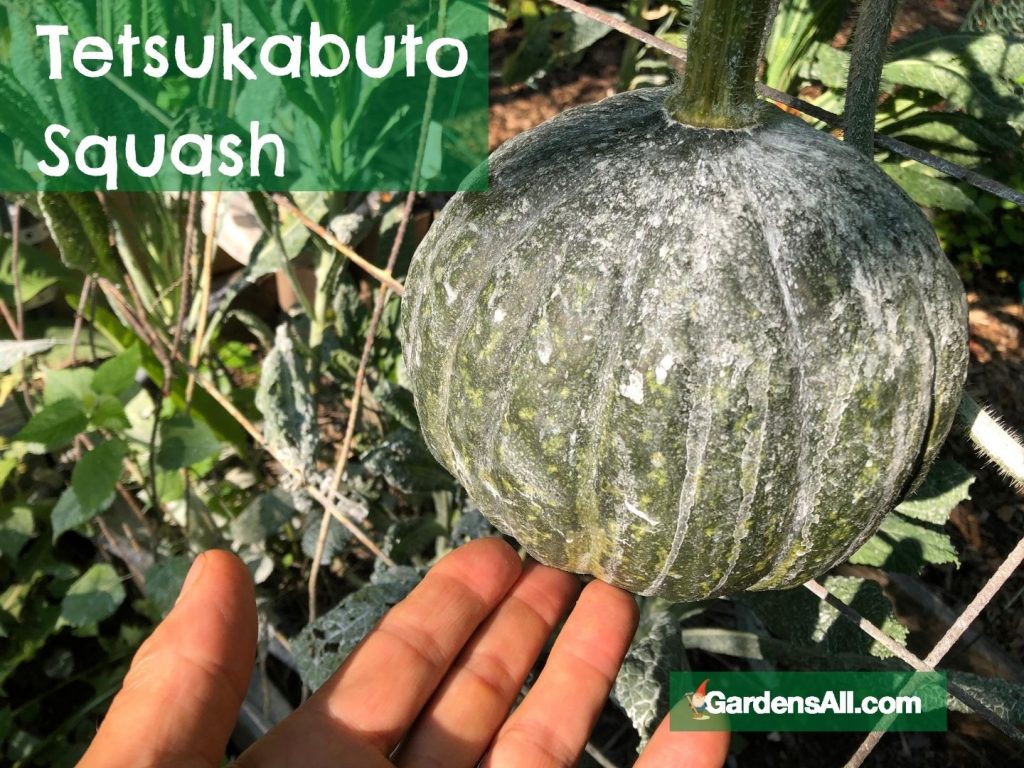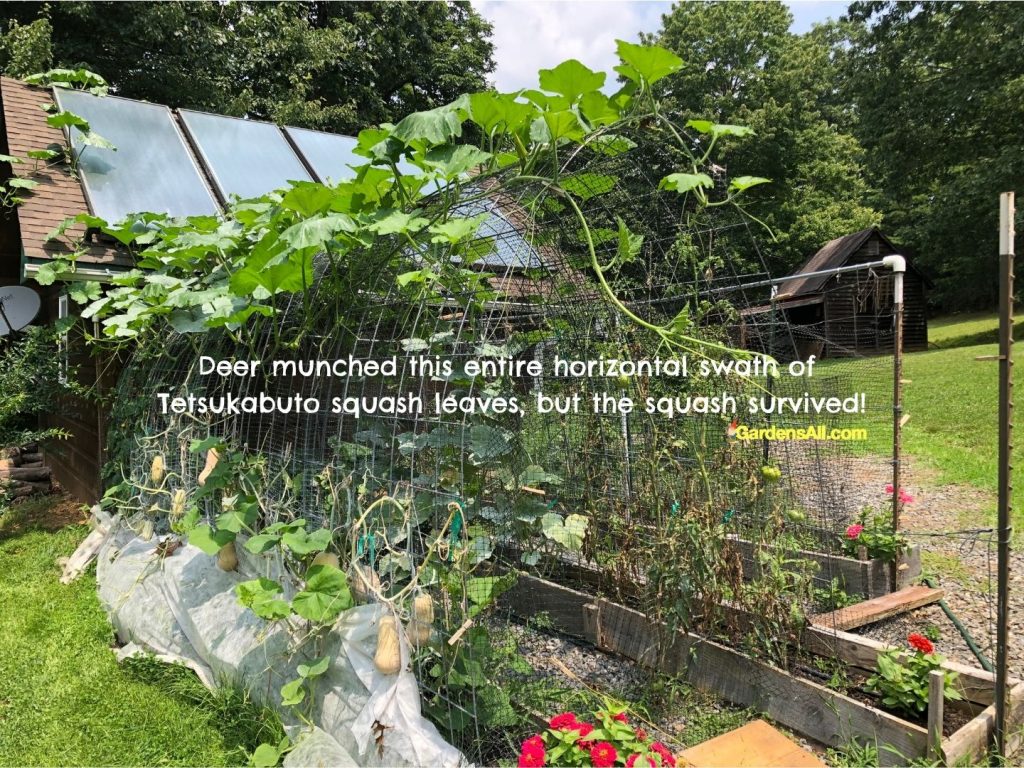We are amazed at this amazing Tetsukabuto squash plant!! We’ve grown this Cucurbita maxima for two years running now, and it’s turned out to be a resounding success.
If you’ve ever lost squash to squash bugs or squash vine borers, then definitely give this Tetsukabuto bug and pest resistant hardy winter squash a try.
Tetsukabuto Squash – Growing Like Crazy
In this video you’ll see our Tetsukabuto squash growing up over our cattle panel trellis and onto and over the roof of our stove house.
We’re now harvesting some and setting them out to cure so we can begin eating them in a couple weeks and into winter.
That’s a wonderful thing about winter squash: they keep for long periods just waiting for when you need them.

Tetsukabuto Squash Description
- Adaptable
- Easy to grow
- Flavorful:
- sweet
- nutty
- Hardy
- Harvest:
- cure 6 weeks before eating
- weight – 4 pounds average
- High yields
- Hybrid kabocha and butternut squash cross
- Long-lasting / long storage capacity
- Pollination – plant near any of these:
- butternut
- kabocha
- hubbard
- buttercup
- Productive
- Resistance to:
- squash bug
- squash vine borer
- powdery mildew
- Rootstock use – can strengthen resiliency, pest and disease resistance for melons and cucumber
How to Grow Tetsukabuto
- CULTURE: Fertile, well-drained soil with a pH of 6.0–6.8
- PLANT SPACING:Bush to short-vine habits generally require 6′ between-row spacing, while long-vine habits require 12′ between-row spacing. In-row spacing depends on fruit size and is generally: small, 18–24″; medium, 24–36″; large, 36–48″.
- DISEASES: Powdery mildew resistant, but watch for common cucurbit diseases including:
- powdery mildew
- downy mildew
- bacterial wilt
- phytophthora
- GROWING CONDITIONS – Insure good:
- soil drainage
- air flow
- rotate crops
- INSECT PESTS – keep an eye out for
- Cucumber beetles
- Squash bugs
- Vine borers
- HARVEST:
- harvest before hard frost
- Cut fruits from vines and handle carefully
- CURE:
- Outdoors – Sun cure, 5-7 days, or
- Indoors – 2 weeks at 80–85°F / 27–29°C with good air circulation
- STORAGE:
- 50–60°F/10–15°C and good ventilation
- Can keep up to 6 months.
- TEMPERATURES:
- 50°F/10°C may cause chilling damage.
- DAYS TO MATURITY – Subtract about 14 days if transplanting:
- 90 days from direct seeding
- 50–55 days after fruit set
Growing Tetsukabuto Squash
In this video, Coleman Alderson talks about growing this hardy and prolific winter squash.
Tetsukabuto Squash is Deer Resilient
It turns out that the deer did eat a wide swath of leaves from our Tetsukabuto plants, so they are not deer resistant. However, we’re calling them deer resilient, because ours continued to grow on and produce great fruit in spite of the deer raid!
We missed treating for the deer after a rain, so they did munch the Tetsu leaves, but fortunately, the squash survived!
Otherwise, our best deer repellent works so long as reapplied after rain!

I’m LeAura Alderson, a garden, herb and plant enthusiast with a passion for discovering the many edible and medicinal benefits of the plants all around us, including the weeds! I’m a writer, editor and media publisher for our family of websites.
While I was certified in fitness and life coaching, I am NOT a health practitioner. However, I’m a lifelong health enthusiast, with a keen interest in healthy, organic foods and making home remedies and the content we share is from our own experience and usage as well as that extracted from scientific research so that you can explore further on your own.
Always seek the advice and guidance of your health practitioners first and foremost.
As a family we’re steadily expanding our gardening, experimentation and knowledge around all things gardening, edible landscaping, fresh organic foods and self sustainability with farming in our future. I also own and manage iCreateDaily.com, a site all about transformation through creation, and the power of positivity, optimism and mindset.

